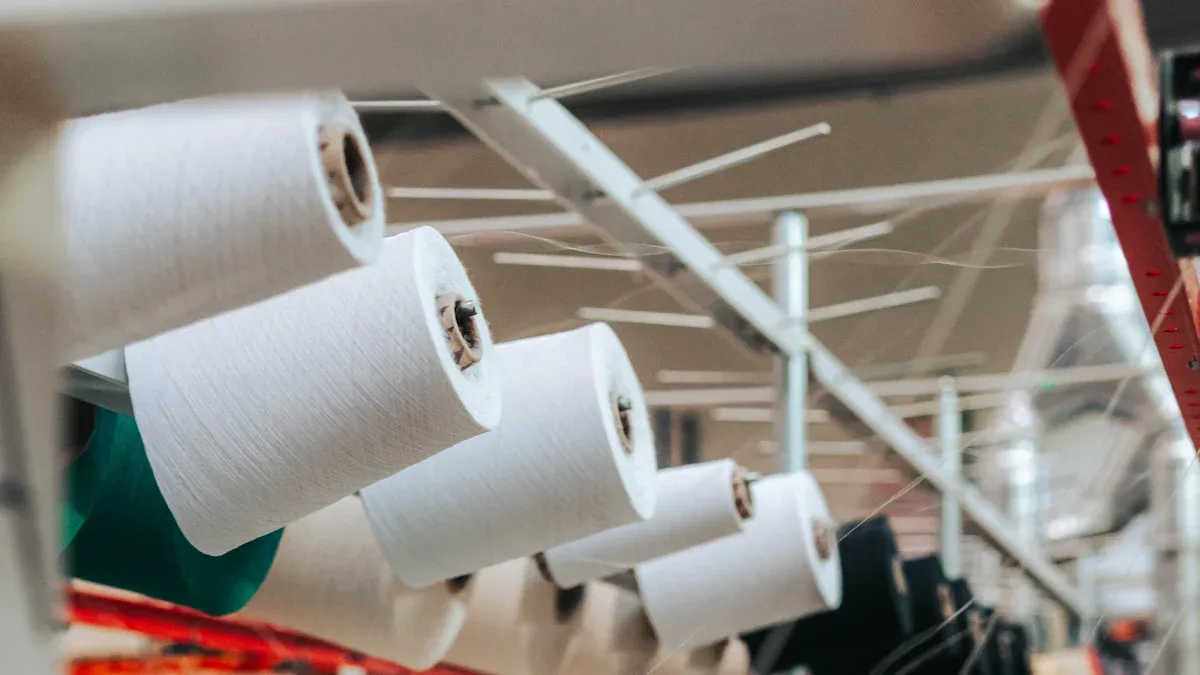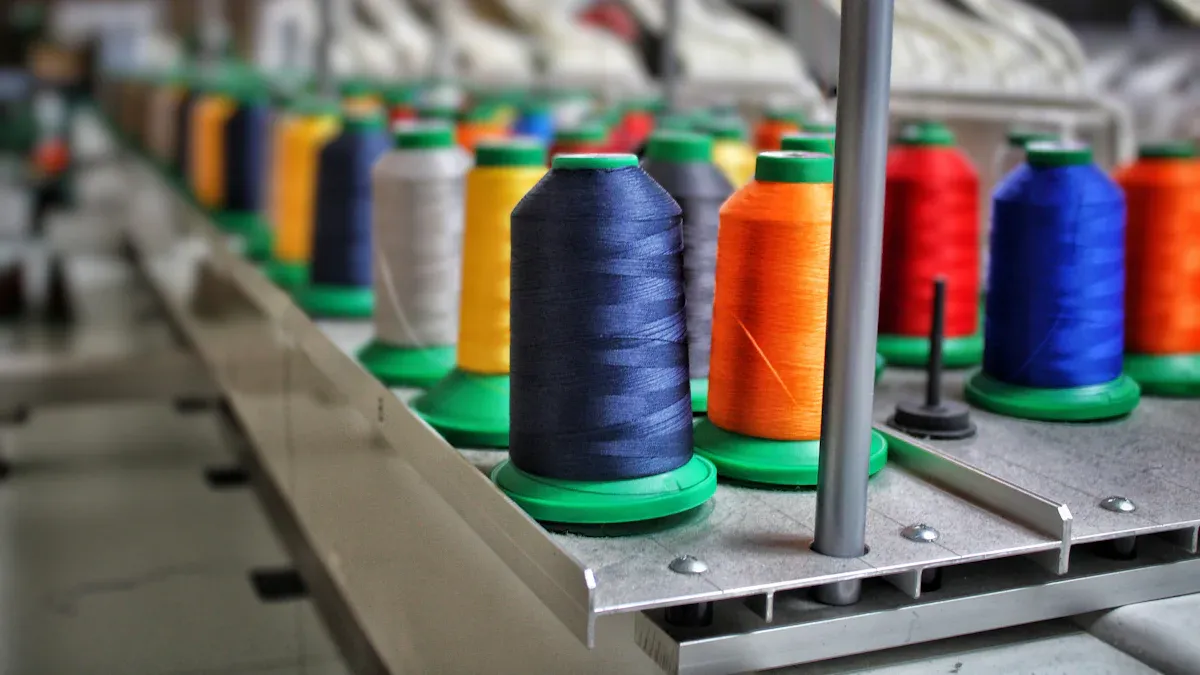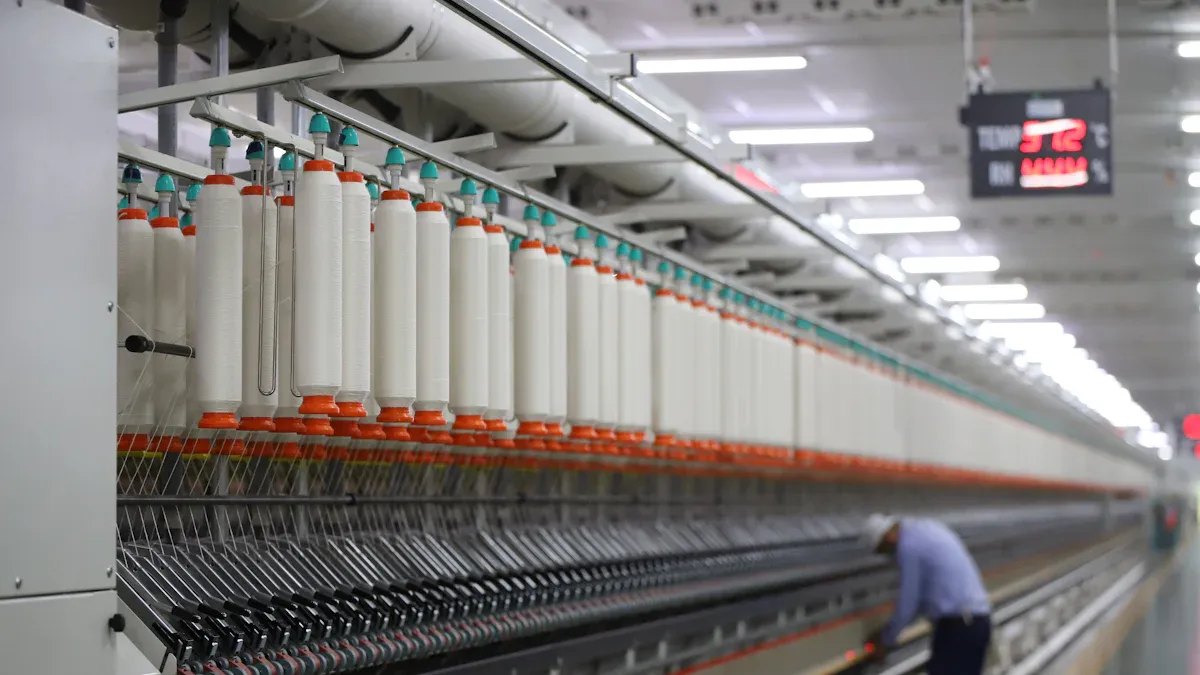
Yarn production demands precision and efficiency to meet market expectations. Cost-effective false-twist machines enhance yarn quality while maintaining operational affordability. Upgrading to one-step twisting machines transforms manufacturing processes by improving efficiency and ensuring consistent output.
- These machines streamline operations by reducing processing stages.
- They achieve higher yarn capacity compared to conventional methods.
- Their lower power consumption optimizes energy usage, reducing costs.
Choosing the right equipment requires evaluating its features, durability, and long-term value. A trusted One-step False Twisting Machine manufacturer can provide tailored solutions for diverse production needs.
Key Takeaways
- One-step twisting machines make work faster by doing many tasks at once. This saves time and money.
- Using energy-saving machines cuts costs and helps the environment, making businesses more successful.
- Taking care of machines, like oiling and cleaning them, helps them last longer and keeps yarn quality steady.
- Picking the right machine means looking at what you need and checking different brands to find the best one.
- Working with skilled manufacturers gives you better tools and training, helping you get the most from new machines.
Understanding False-Twist Machines

What Are False-Twist Machines
False-twist machines play a pivotal role in modern textile manufacturing. These machines introduce a temporary twist to yarns during the production process, which is later removed to achieve the desired texture and elasticity. By manipulating the yarn’s structure, they enhance its strength, appearance, and functionality. This process is essential for creating high-performance fabrics used in industries ranging from fashion to technical textiles.
The evolution of false-twist machines has been driven by technological advancements. Modern systems incorporate intelligent automation and data analytics, enabling manufacturers to optimize productivity and reduce downtime. Additionally, these machines are designed to accommodate diverse yarn types, making them versatile tools for addressing fluctuating market demands. Aligning with sustainability goals, many manufacturers now prioritize energy-efficient designs, contributing to a circular textile economy.
Benefits of One-Step Twisting Machines
One-step twisting machines represent a significant leap forward in textile machinery. These machines streamline the twisting process by combining multiple stages into a single operation, reducing complexity and improving efficiency. Their benefits extend beyond operational simplicity, offering tangible advantages for manufacturers.
- Enhanced Productivity: By consolidating processes, one-step machines increase production speed and capacity. This efficiency allows manufacturers to meet tight deadlines and scale operations effectively.
- Cost Savings: Lower energy consumption and reduced maintenance requirements translate to significant cost reductions over time. These machines also minimize material waste, further enhancing profitability.
- Consistent Yarn Quality: Advanced technology ensures uniform twisting, resulting in high-quality yarns with consistent properties. This reliability strengthens the market value of finished products.
- Adaptability: One-step machines can handle a wide range of yarn types and applications, providing flexibility for manufacturers to diversify their product offerings.
Market research highlights the operational capabilities of these machines, showcasing their ability to meet industry demands. Reports detail their performance metrics, including production rates and energy efficiency, underscoring their value in competitive markets. Collaborating with a trusted One-step False Twisting Machine manufacturer ensures access to cutting-edge technology and tailored solutions for specific production needs.
Tip: Partnering with manufacturers that offer training and consultancy services can maximize the benefits of one-step twisting machines. These partnerships foster long-term success by enhancing operational expertise and minimizing downtime.
Summary of Key Points:
- False-twist machines temporarily alter yarn structure to improve texture, strength, and elasticity.
- Modern systems integrate automation, data analytics, and energy-efficient designs.
- One-step twisting machines streamline operations, reduce costs, and ensure consistent yarn quality.
- Collaborating with a reliable One-step False Twisting Machine manufacturer provides access to advanced technology and expert support.
Key Features of Cost-Effective Machines
Energy Efficiency and Operational Costs
Modern twisting machines prioritize energy efficiency to align with sustainability goals and reduce operational expenses. These machines integrate advanced automation systems that optimize production processes, minimizing human errors and enhancing consistency. Manufacturers report up to 30% productivity increases due to automation, which significantly reduces labor costs.
A focus on eco-friendly materials further contributes to cost-effectiveness. Machines designed with recyclable components lower the ecological footprint throughout their lifecycle. Predictive maintenance systems also play a crucial role in reducing operational costs. By proactively addressing potential issues, manufacturers can save over $100,000 annually in repair expenses.
| Metric Type | Description |
|---|---|
| Energy Consumption Reductions | Twisting machines focus on reducing energy usage, aligning with sustainability trends. |
| Automation Integration | Enhanced production efficiency through automation, reducing human errors and increasing consistency. |
| Productivity Increases | Companies report up to 30% productivity increases with automation, leading to reduced labor costs. |
| Predictive Maintenance Savings | Proactive maintenance can save manufacturers over $100,000 annually by minimizing repair costs. |
| Eco-friendly Materials | Use of recyclable materials reduces ecological footprint throughout the machine’s lifecycle. |
Tip: Partnering with a reliable One-step False Twisting Machine manufacturer ensures access to energy-efficient designs and cutting-edge automation technologies.
Durability and Maintenance
Durability is a cornerstone of cost-effective twisting machines. High-quality components and robust designs ensure long-term reliability, reducing the need for frequent replacements. Regular lubrication of moving parts minimizes friction and wear, while periodic inspections help identify and address issues promptly.
Maintenance practices also contribute to machine longevity. Keeping machines clean prevents blockages and overheating, while moisture-proof and rust-proof measures protect equipment in humid environments. Avoiding overload safeguards machines from excessive strain, ensuring consistent performance over time.
- Regular lubrication reduces wear and tear.
- Cleanliness prevents overheating and blockages.
- Periodic inspections address issues before they escalate.
- Moisture-proof measures protect against rust in humid conditions.
These practices not only extend the lifespan of twisting machines but also reduce downtime, enhancing overall productivity.
Speed and Production Capacity
Cost-effective twisting machines excel in speed and production capacity, enabling manufacturers to meet tight deadlines and scale operations efficiently. By consolidating multiple processes into a single operation, one-step machines streamline production workflows. This integration boosts output rates while maintaining consistent yarn quality.
Advanced automation systems further enhance production capacity. These systems ensure uniform twisting, reducing material waste and improving the reliability of finished products. Manufacturers benefit from faster turnaround times, allowing them to respond quickly to market demands.
Note: Investing in high-speed machines with adaptable features allows manufacturers to diversify their product offerings and stay competitive in dynamic markets.
Summary of Key Points:
- Energy-efficient designs reduce operational costs and align with sustainability goals.
- Durable components and proactive maintenance practices extend machine lifespan and minimize downtime.
- High-speed production capabilities enable manufacturers to scale operations and meet market demands effectively.
Balancing Price and Long-Term Value
Initial Investment vs. Savings
Investing in advanced textile machinery often requires a significant upfront cost. However, the long-term savings and operational benefits justify this expenditure. One-step twisting machines, for instance, reduce energy consumption and streamline production processes. These efficiencies lower operational costs, enabling manufacturers to recover their initial investment more quickly.
Modern machines also minimize material waste, which directly impacts profitability. By producing consistent, high-quality yarns, manufacturers can reduce defects and rework, saving both time and resources. Additionally, predictive maintenance systems integrated into these machines prevent costly breakdowns. This proactive approach ensures uninterrupted production, further enhancing cost efficiency.
Tip: Collaborating with a trusted One-step False Twisting Machine manufacturer ensures access to reliable equipment and expert guidance, maximizing return on investment.
Enhancing Yarn Quality and Market Value
High-quality yarns command premium prices in competitive markets. One-step twisting machines play a crucial role in achieving this standard. Their advanced technology ensures uniform twisting, resulting in yarns with superior strength, elasticity, and texture. These qualities enhance the performance of finished fabrics, making them more appealing to end-users.
Manufacturers who prioritize yarn quality gain a competitive edge. Consistent output builds customer trust and opens doors to high-value markets, such as technical textiles and luxury apparel. Furthermore, the adaptability of one-step machines allows manufacturers to diversify their product range, catering to evolving market demands.
Note: Investing in machines that enhance yarn quality not only boosts market value but also strengthens brand reputation, fostering long-term business growth.
Summary of Key Points:
- Initial investments in advanced machines lead to significant long-term savings through reduced energy use and material waste.
- Predictive maintenance systems prevent costly downtime, ensuring consistent production.
- High-quality yarns produced by one-step machines increase market value and customer trust.
- Collaborating with a reliable One-step False Twisting Machine manufacturer maximizes operational efficiency and profitability.
Choosing the Right Machine
Assessing Production Needs
Selecting the right twisting machine begins with understanding specific production requirements. Manufacturers must evaluate factors such as yarn strength, twist direction, and cleanliness to ensure optimal machine performance. Each factor directly impacts the quality and efficiency of yarn production.
| Factor | Impact on Machine Performance |
|---|---|
| Yarn Strength | Insufficient strength can lead to breaks during knitting, causing production interruptions and defects. |
| Twist and Direction | Affects strength, abrasion resistance, and overall quality of the socks produced. |
| Cleanliness | Impurities can block guides and needles, leading to failures; fuzz can affect tension and stability of knitting. |
Machines designed to address these challenges deliver consistent results and reduce downtime. For example, advanced twisting systems ensure uniform twist direction, enhancing yarn durability and abrasion resistance. Cleanliness-focused designs prevent blockages, maintaining smooth operations. Manufacturers should prioritize machines that align with their production goals to maximize efficiency and profitability.
Tip: Conducting a thorough analysis of production needs before purchasing ensures the machine’s capabilities match operational demands.
Comparing Brands and Models
The textile machinery market offers a wide range of brands and models, each with unique features and benefits. Comparing these options requires a systematic approach to identify the best fit for specific production requirements. Key considerations include performance metrics, energy efficiency, and adaptability.
- Performance Metrics: Evaluate production speed, capacity, and yarn quality consistency. Machines with higher output rates and uniform twisting capabilities often deliver better results.
- Energy Efficiency: Look for models with low power consumption and eco-friendly designs. Energy-efficient machines reduce operational costs and align with sustainability goals.
- Adaptability: Choose machines capable of handling diverse yarn types and applications. Versatile systems allow manufacturers to expand their product offerings and meet market demands.
Manufacturers should also consider customer reviews and industry reputation when comparing brands. Reliable companies often provide comprehensive support, including training and maintenance services. Partnering with a trusted One-step False Twisting Machine manufacturer ensures access to cutting-edge technology and tailored solutions.
Note: Investing in machines from reputable brands minimizes risks and ensures long-term reliability.
Insights from a One-step False Twisting Machine Manufacturer
Leading manufacturers of one-step false twisting machines offer valuable insights into optimizing production processes. Their expertise helps manufacturers select equipment that aligns with operational goals and industry trends. Companies like LANXIANG MACHINERY, with decades of experience in textile machinery innovation, exemplify this approach.
Established in 2002, LANXIANG MACHINERY specializes in high-performance textile equipment, including false twisters and texturing machines. Their “Twist, Divide, Transform” philosophy drives the development of advanced systems that enhance yarn quality and production efficiency. With a 20,000-square-meter R&D hub, the company delivers customized solutions tailored to diverse production needs.
Collaborating with such manufacturers provides access to state-of-the-art technology and expert guidance. They offer training programs, consultancy services, and precision components to maximize machine performance. Manufacturers benefit from reduced downtime, improved yarn quality, and increased profitability.
Tip: Partnering with experienced manufacturers ensures long-term success by leveraging their expertise and innovative solutions.
Summary of Key Points:
- Assessing production needs helps identify machines that address challenges like yarn strength, twist direction, and cleanliness.
- Comparing brands and models involves evaluating performance metrics, energy efficiency, and adaptability.
- Insights from trusted manufacturers, such as LANXIANG MACHINERY, provide access to advanced technology and tailored solutions.
Real-World Applications

Case Studies of Successful Upgrades
Upgrading to one-step twisting machines has transformed operations for many manufacturers, improving both yarn quality and production efficiency. A comparative analysis of yarn properties before and after machine upgrades highlights these benefits. The following table illustrates the impact of different ring types on yarn performance metrics:
| Ring Type | Yarn Unevenness (%) | Yarn Imperfection (%) | Yarn Tenacity (%) | Yarn Hairiness (%) |
|---|---|---|---|---|
| Ring A | 4.14 | 18.54 | 3.35 | 10.63 |
| Ring B | 4.15 | 3.47 | 0.64 | 12.31 |
The data reveals a significant reduction in yarn imperfections and unevenness with Ring B, demonstrating the effectiveness of advanced twisting technology. Manufacturers using Ring B reported smoother operations and fewer defects, leading to higher customer satisfaction. Additionally, the improved yarn tenacity and reduced hairiness enhanced the durability and appearance of finished fabrics.
These upgrades also streamlined production workflows. By consolidating multiple processes into a single operation, manufacturers achieved faster turnaround times and reduced material waste. This efficiency allowed them to meet tight deadlines and expand their market reach.
Tip: Investing in advanced twisting machines not only improves yarn quality but also enhances operational efficiency, providing a competitive edge in the textile industry.
Common Mistakes to Avoid
While upgrading to one-step twisting machines offers numerous benefits, manufacturers must avoid common pitfalls to maximize their investment. One frequent mistake involves neglecting proper machine maintenance. Failing to lubricate moving parts or clean components regularly can lead to breakdowns and increased downtime.
Another common error is underestimating production needs. Selecting a machine with insufficient capacity or limited adaptability can hinder scalability and restrict product diversification. Manufacturers should conduct a thorough analysis of their operational requirements before making a purchase.
Improper training of machine operators also poses a significant risk. Without adequate knowledge, operators may struggle to utilize advanced features effectively, leading to suboptimal performance. Partnering with manufacturers that offer training programs can mitigate this issue.
Note: Avoiding these mistakes ensures a smoother transition to advanced machinery and maximizes the return on investment.
Summary of Key Points:
- Case studies demonstrate significant improvements in yarn quality and operational efficiency after machine upgrades.
- Proper maintenance, accurate assessment of production needs, and operator training are essential for successful implementation.
- Advanced twisting machines enhance productivity, reduce defects, and strengthen market competitiveness.
Selecting the right false-twist machine requires careful consideration of price and performance. Manufacturers should prioritize long-term value by choosing energy-efficient designs that reduce operational costs and enhance production capacity. One-step twisting machines offer a strategic advantage by streamlining processes and delivering consistent yarn quality.
Key Takeaway: Investing in advanced machinery improves operational efficiency, strengthens market competitiveness, and ensures high-quality output, making it a valuable choice for textile manufacturers.
FAQ
What is the lifespan of a one-step twisting machine?
The lifespan of a one-step twisting machine depends on its build quality and maintenance. Machines from reputable manufacturers, like LANXIANG MACHINERY, often last over 10 years with proper care. Regular lubrication, cleaning, and inspections significantly extend their operational life.
Tip: Follow the manufacturer’s maintenance guidelines to maximize machine longevity.
How can manufacturers ensure consistent yarn quality?
Consistent yarn quality requires using advanced machines with uniform twisting capabilities. One-step twisting machines integrate automation to minimize errors. Regular maintenance, such as cleaning and inspecting components, also ensures smooth operations and consistent output.
Note: Investing in high-quality machines reduces defects and enhances yarn performance.
Are one-step twisting machines suitable for all yarn types?
Yes, most one-step twisting machines are versatile and can handle various yarn types. Manufacturers design these machines to accommodate different textures, strengths, and applications, making them ideal for diverse production needs.
Key Point: Verify the machine’s specifications to ensure compatibility with specific yarn requirements.
How do one-step twisting machines reduce operational costs?
One-step twisting machines reduce costs by consolidating multiple processes into a single operation. Their energy-efficient designs lower power consumption, while automation minimizes labor expenses. Predictive maintenance systems further cut repair costs by preventing breakdowns.
Reminder: Choose machines with energy-saving features to maximize cost efficiency.
What training is required for operating these machines?
Operators need basic training to understand the machine’s features and functions. Many manufacturers, like LANXIANG MACHINERY, offer training programs to ensure operators can use the equipment effectively. Proper training minimizes errors and enhances productivity.
Tip: Partner with manufacturers that provide comprehensive training and support.
Summary of Key Points:
- Proper maintenance extends machine lifespan and ensures consistent yarn quality.
- One-step twisting machines are versatile, cost-effective, and suitable for diverse yarn types.
- Training programs enhance operator efficiency and reduce operational errors.
Post time: Jun-06-2025
 Phone: +8613567545633
Phone: +8613567545633 E-mail: lanxiangmachine@foxmail.com
E-mail: lanxiangmachine@foxmail.com 